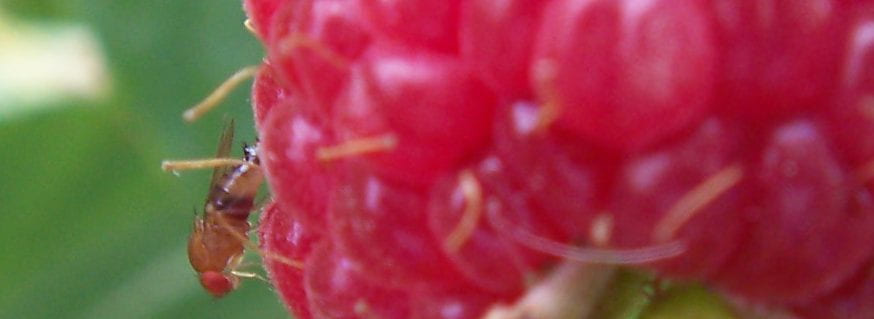Sustained catch, was obtained in 11 berry plantings in nine counties in NY between June 23 and 29. Trap catch numbers are creeping up and are hitting higher numbers some locations. Harvest continues in June strawberries and is now underway in raspberries (yum, my personal favorite) and blueberries.
With SWD found across most traps in NY and numbers climbing, it will be imperative to begin a spray program to protect fruit. SWD populations built up this year to coincide with berry and cherry harvests. This translates into a challenging year for SWD management.
Sustained catch on June 23
- Clinton County – 1 male and 1 female in a blueberry planting.
- Essex County - 6 males and 16 females in a raspberry planting.
- Orange County - 35 males and 21 females in a raspberry field.
Sustained catch on June 25
- Saratoga County – 4 males and 10 females in a blackberry planting.
- Saratoga County – 3 males and 5 females in a tart cherry orchard.
- Schuyler County - 1 male and 2 females in a blueberry planting.
- Schuyler County - 1 male and 9 females in a raspberry planting.
- Cayuga County - 1 males and 2 females in a raspberry planting.
Sustained catch on June 29
- Columbia County - 2 males and 4 females in a tart cherry orchard.
- Washington County - 1 male and 7 females in a blueberry planting.
- Wayne County - 1 female in a raspberry planting.

SWD has now been found in traps set in all but two counties in the monitoring network, but that doesn't mean it's not present in those counties. It is time to take SWD management seriously. If adult SWD are present on your farm, manage them aggressively now that harvests are underway and imminent.
Aggressive SWD management entails 5 key tactics:
- Excellent sanitation will reduce SWD populations.
Fruit should be harvested frequently and completely to prevent the buildup of ripe and over-ripe fruit. Unmarketable fruit should be removed from the field and either frozen, “baked” in clear plastic bags placed in the sun, or disposed of in bags off-site. This will kill larvae, remove them from your crop, and prevent them from emerging as adults.
- Canopy and water management will make the environment less favorable.
Prune to maintain an open canopy, increase sunlight and reduce humidity. This will make plantings less attractive to SWD and will improve spray coverage. Repair leaking drip lines and avoid overhead irrigation when possible. Allow the ground and mulch surface to dry before irrigating.
- Insecticide sprays will kill SWD adults and thereby reduce egg laying:
Insecticide treatments should begin when either regional monitoring alerts about the first SWD trap catch or when highly susceptible fruit crops begin to ripen. Treatments should be applied at least every seven days and repeated in the event of rain. Choose the most effective insecticides with pre harvest intervals that work for your picking schedule.
Rotate insecticides according to their modes of action.
Quick reference guides:
- SWD insecticides for berries (http://www.hort.cornell.edu/fruit/pdfs/swd/berry-insecticides.pdf)
- SWD insecticides for stone fruits and grapes (www.hort.cornell.edu/fruit/pdfs/swd/treefruit-grape-insecticides.pdf)
- SWD insecticides for treating dropped fruit (www.hort.cornell.edu/fruit/pdfs/swd/drop-cull-insecticides.pdf)
Check the Cornell Guidelines (cropandpestguides.cce.cornell.edu/) for the latest list of approved pesticides. Special needs labels are being sought for NY berries. Always read and follow the pesticide label instructions.
- Regular fruit sampling:
At least 100 fruit per block per harvest should be observed for infestation. Talk to your local CCE agent about a monitoring program. Fruit can be inspected for evidence of larval feeding. Small holes in berries where the eggs were laid may leak juice when the berry is gently squeezed; this is especially diagnostic on blueberry. Infested red raspberry fruit may leave a red juice stain on the berry receptacle when the fruit is picked. Fruit with small indents or bruises where the berry surface appears to have flattened or deflated may be damaged.
A salt flotation method, immersing fruit in a solution of 1 Tbsp. (14.8 cc) table salt per 1 cup (236.6 ml) water, may cause larvae to float to surface. At least 100 fruit per block per harvest should be observed for infestation. Suggested methods were adapted for NY growers in Guidelines for Checking Fruit for SWD Larvae in the Field (https://cpb-us-e1.wpmucdn.com/blogs.cornell.edu/dist/0/7265/files/2017/01/SaltFloatation-2kmt284.pdf).
- Cool berries immediately:Chilling berries immediately after harvest to 32o – 33o F will slow or stop the development of larvae and eggs in the fruit. U-Pick customers should be encouraged to refrigerate fruit immediately to maintain fruit quality at home.
Learn more about SWD. Check out the information on Cornell Fruit Resources Spotted Wing Drosophila, http://fruit.cornell.edu/spottedwing/.
Thanks go out to:
- Elisabeth Hodgdon, ENYCHP CCE, who is monitoring Clinton County
- Andy Galimberti, ENYCHP CCE, who is monitoring Essex County
- Natasha Field, ENYCHP CCE, who is monitoring Saratoga and Columbia Counties
- Grace Marshall, NYSIPM CCE, who is monitoring Cayuga, Schuyler and Wayne Counties
- Sarah Tobin, ENYCHP CCE, who is monitoring Orange County
- Laura McDermott, ENYCHP CCE, who is monitoring Washington County

